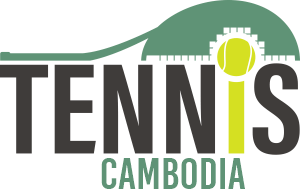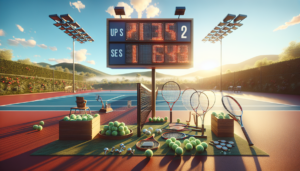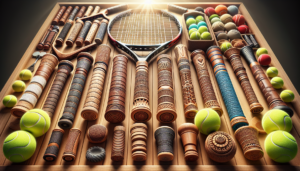Understanding Tennis Serve Speed
A tennis serve is one of the most important shots in the game, setting the tone for each point. The speed of a serve can give a player a significant advantage, allowing them to dictate the pace and direction of the rally. Serve speed is a key factor in tennis, with top players regularly hitting serves over 130 mph. But what exactly is tennis serve speed, and how can players improve it?
The Importance of Serve Speed in Tennis
Tennis serve speed refers to how fast the ball travels when hit by a player during their service motion. A faster serve gives the opponent less time to react and can lead to more aces and service winners. It also puts pressure on the receiver, forcing them to hit a defensive shot that the server can then attack.
History has shown that players with dominant serves tend to perform better, especially on fast surfaces like grass and indoor hard courts. A powerful serve can be a great equalizer, allowing players to hold serve more easily and putting them in a position to break their opponent’s serve.
Historical Serve Speed Records
Over the years, there have been some incredible feats of serving speed. Here are some of the fastest serves ever recorded:
| Player | Serve Speed | Event |
|---|---|---|
| Sam Groth | 163.7 mph | 2012 ATP Challenger |
| John Isner | 157.2 mph | 2016 Davis Cup |
| Ivo Karlovic | 156.0 mph | 2011 Davis Cup |
While these speeds are incredible, it’s important to note that most recreational players will never come close to hitting a serve this fast. Even at the professional level, the average first serve speed is around 120 mph for men and 100 mph for women.
Techniques to Improve Your Tennis Serve Speed
If you’re looking to add some extra mph to your serve, there are a few key techniques you can focus on. Proper biomechanics, coupled with strength and power training, can make a big difference in your serve speed over time.
Proper Serve Timing and Motion
One of the most important factors in generating serve speed is timing. The serve motion is a complex chain of events that requires precise coordination of the legs, trunk, shoulders, elbow, and wrist.
Key elements of a good serve motion for maximizing speed include:
- Knee bend and push off the ground with the legs
- Trophy pose at the top of the backswing
- Internally rotated shoulder and vertical racquet in the trophy pose
- Fast and explosive swing up to contact
- Pronation of the arm and wrist through contact
Drilling these positions and working on serve speed progressions can help you groove a more efficient and powerful service motion.
Grip and Stance Adjustments
While less impactful than the service motion, grip and stance can also influence serve speed. A continental or eastern backhand grip allows for greater wrist snap and racquet head speed compared to an eastern forehand grip.
In terms of stance, a platform stance may allow for more power and racquet head speed compared to a pinpoint stance, as the feet remain stable through the motion. However, many players are able to generate tons of pace from a pinpoint stance as well.
Ultimately, it’s important to find a grip and stance that feel comfortable and allow you to maximize your serve speed without sacrificing too much control and consistency.
Using Visual Feedback Tools
Tracking your serve speed with a radar gun can be a helpful training tool. It provides immediate feedback and allows you to correlate how your service motion and technique impact the speed readings.
Many players find it motivating to track progress over time and try to set personal bests. Some even gain confidence from seeing high numbers pop up on the radar gun, creating a positive feedback loop.
However, it’s important not to get too obsessed with radar gun readings at the expense of other aspects of your serve like spin, placement, and consistency. Radar guns are best used periodically as a feedback tool rather than an everyday necessity.
Training Regimens for Enhancing Serve Speed
In addition to proper technique, building the strength and power of your serve requires tailored off-court training. A comprehensive approach that develops relevant musculature and movement patterns will translate to more mph on your serve.
Strength and Power Training
Strength forms the foundation for power and speed. Tennis-specific strength training should focus on exercises for the legs, core, rotator cuff, and forearm muscles that are heavily involved in the service motion.
Compound exercises like squats, deadlifts, pullups, presses, and rows help build full body strength that transfers to the court. Unilateral variations challenge balance and stability for added specificity.
With a strong foundation in place, power training aims to increase your ability to generate force rapidly. Plyometric exercises like box jumps, medicine ball throws, and elastic band exercises teach your neuromuscular system to accelerate quickly.
Dedicated Serve Speed Sessions
To further target your serve speed, incorporate dedicated serving sessions into your practice schedule. These focused sessions of around 30-60 minutes should have the express purpose of hitting for maximum speed and testing those missile radar readings.
A good serve speed session involves:
- Thorough dynamic warmup
- Technique drills isolating specific positions
- Target serving focusing on speed
- Charting metrics like speed, spin rpm, and percentages
- Active recovery between hitting rounds
Start with 2-3 serve speed sessions per week, monitoring fatigue and adjusting intensity as needed. Film your sessions periodically to analyze your motion and identify areas for improvement.
Incorporating Rest and Recovery
Serving at max intensity places a lot of stress on the body, particularly the shoulder and elbow joints. Ample rest between serve speed sessions is critical for injury prevention and ensuring you can perform at your best.
Respect your body’s need to recover with a day off from serving or even tennis altogether at least once a week. Maintain flexibility and tissue quality with a regular stretching routine and soft tissue work using foam rollers or massage.
If you feel any pain during or after serving, back off and assess the root cause. Trying to power through pain will only exacerbate injuries in the long run.
Notable Players and Their Serve Speeds
Let’s take a look at some of the biggest servers in the history of the sport and the jaw-dropping speeds they were able to attain.
Top 10 Fastest Serves in Tennis History
The fastest official serves on record were struck by:
- Sam Groth – 163.7 mph
- Albano Olivetti – 160.0 mph
- John Isner – 157.2 mph
- Ivo Karlovic – 156.0 mph
- Andy Roddick – 155.0 mph
- Milos Raonic – 155.3 mph
- Jerzy Janowicz – 152.5 mph
- Marius Copil – 151.6 mph
- Feliciano Lopez – 152.0 mph
- Hubert Hurkacz – 151.0 mph
It’s interesting to note that many of these players are very tall, with a few like Isner, Karlovic, and Raonic eclipsing the 6’10” mark. This extra height provides a natural advantage on serve, allowing them to hit down on the ball from a higher contact point.
Analysis of Techniques Used by Top Servers
While the top servers employ somewhat different motions, they all excel at creating racquet head speed through the kinetic chain. Slow motion video analysis reveals certain commonalities:
- Exceptional leg drive and ground force production
- Hip-shoulder separation and trunk rotation
- “Bow and arrow” stretch of the chest and shoulder
- Incredible racquet head acceleration and snap
- Full extension up and out to the ball
Apart from biomechanics, these players also tend to have robust strength and conditioning regimens to support their serving prowess. Targeted exercises for the legs, core, shoulders, chest, and wrists provide the horsepower to break speed guns.
Future of Tennis Serve Speed
As the sport of tennis continues to evolve, how much faster can serves go? Will we see a player crack the elusive 180 mph barrier? Advancements in technology and training methods provide clues to the future of serve speed.
Technological Advancements in Serve Speed
Tennis equipment manufacturers continue to push the envelope with racquet and string designs that can help players generate more power and spin. Stiffer and lighter racquets made of advanced carbon fiber materials improve stability and swing speed.
Polyester strings also play a major role, with their stiff and slick properties enabling more spin and pace on serves. Players are constantly tinkering with string tension, gauge, and pattern to find the perfect recipe.
Other technological advancements like motion tracking sensors, high speed cameras, and biomechanical analysis software allow players and coaches to optimize the service motion for maximum speed and efficiency.
The Role of Research and Development
The world’s top tennis federations and academies are increasingly investing in sport science research to enhance player development. Academics are teaming up with coaches to investigate all the factors that contribute to serve speed.
Studies range from 3D kinematic analysis of the world’s top servers to measuring ground reaction forces and electromyography (EMG) readings of muscle activation patterns. This data is then used to refine technique and training methods for the next generation.
Researchers are also interested in injury prevention, studying the best ways to build up speed and power while minimizing undue stress on joints. Recovery science is another growing area, with emphasis on proper workload management, nutrition, and sleep.
With concerted efforts to study the tennis serve from all angles, it’s likely that records will continue to be broken as athletes become stronger, faster, and more efficient than ever before. The 180 mph serve remains a tantalizing target – perhaps it’s only a matter of time.






